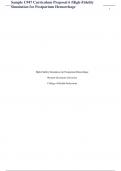Sample C947 Curriculum Proposal 6 /High-Fidelity
Simulation for Postpartum Hemorrhage 1
High-Fidelity Simulation for Postpartum Hemorrhage
Western Governors University
College of Health Professions
,HIGH-FIDELITY SIMULATION FOR POSTPARTUM HEMORRHAGE 2
Executive Summary
This proposal addresses a curriculum gap identified at Western University as the lack of
utilization of high-fidelity simulation (HFS) in the prevention and management of postpartum
hemorrhage module. A proposed curricular change from LFS to High-fidelity simulations (HFS)
to improve the student’s confidence and clinical skills is recommended. The Analysis, Design,
Development, Implementation, and Evaluation (ADDIE) model was utilized as a guide for the
recommended curricular change proposal.
During the analysis phase, a gap analysis was completed to identify the curriculum gap of
their current practice. The analysis discovered that underutilization of HFS in preventing and
managing postpartum hemorrhage module. A thorough literature review was completed that
identified that when nursing students are exposed to simulations, they are more confident and
competent in skills at the clinical facility. A force field analysis was completed to identify forces
that support and oppose the change and to identify the organization's readiness to change. The
force field analysis revealed an absence of the HFS technology utilization that allows educators
to provide students with more real-life practice experience, stimulating decision-making skills,
and more confidence in the workforce.
During the design phase, the course syllabus consisting of the course description, course
objectives, teaching, and instructional strategies, learning materials, student learning outcomes,
course policies, and a grading policy was created. The masters of science nursing (MSN) student
lined up the course syllabus with the module topic from the existing patient-centered care:
childbearing family curriculum to promote the module integration. The nursing student's
diversity at Western University helped increase the knowledge they gained from this course.
,HIGH-FIDELITY SIMULATION FOR POSTPARTUM HEMORRHAGE 3
During the development phase, lecture content, learning resources, and assessments were
developed. A well-organized and informative slide presentation was collaboratively developed
by the MSN student and designated preceptor to present content. Learning resources,
simulations, and student learning activities were developed because they are useful learning tools
to enhance students’ skills, improve communication, and provide care for a patient in a safe
setting. A formative assessment quiz and summative objective assessment were developed to
gather data if the module is meeting the intended goals. An authentic summative performance
assessment of a presentation that focuses on the students learning process and critical thinking
skills was developed.
During the implementation phase, the pilot module implementation is planned. The MSN
student improved, updated, and edited the course content, learning resources, and assessments to
promote a successful presentation to students. Human, financial, and technology resources, like
support from two faculty members, budgeting for labor hours, and simulation equipment needed
to carry out the pilot test were determined. Faculty are trained on the new module and HFS to
help close the curriculum gap. The pilot test is carried out with many points for students and
faculty to provide feedback on the module's content and possible improvements.
During the evaluation phase, the MSN student determined that the module goals were
met by utilizing evaluation tools. The key performance indicators, benchmarks, and student
surveys helped the MSN student improve the proposed module change to close the curriculum
gap. A formative evaluation plan was developed to help analyze if hereafter, the module
implementation within the curriculum will continue to meet the student's and faculty's needs.
Undergraduate nursing students will significantly benefit from implementing this
proposed curricular change by providing improved skills and knowledge about how to care for
, HIGH-FIDELITY SIMULATION FOR POSTPARTUM HEMORRHAGE 4
postpartum hemorrhage patients. Utilizing HFS can enhance students' real-life scenarios, which
can help them understand better and handle similar clinical situations during their nursing
careers.




